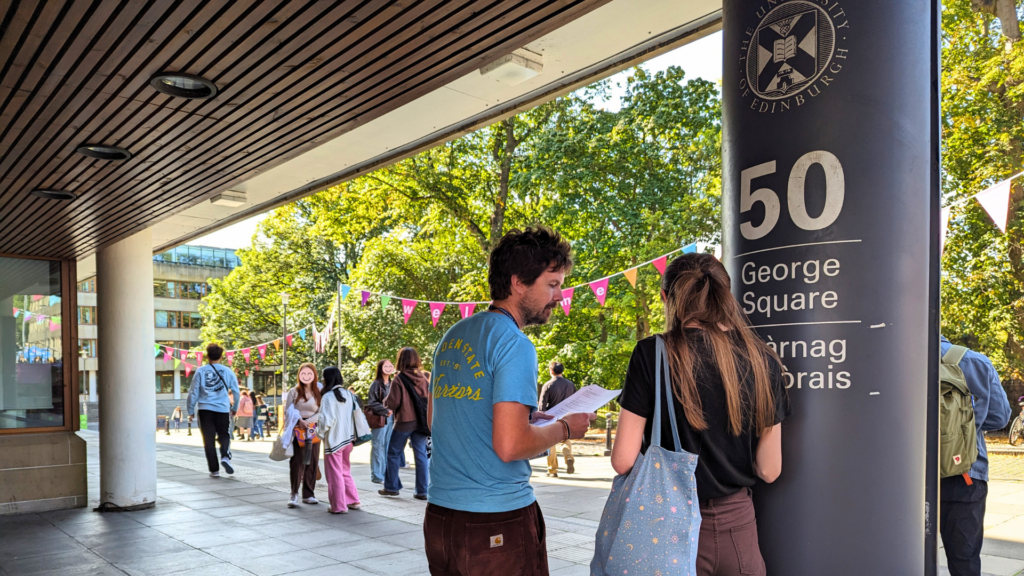Diving in at the deep end: Usability testing on my second day in the team
I joined the Prospective Student Web Content Team in September 2023, and immediately headed out on campus with everyone to conduct usability testing with new students. It was a great way to immerse myself in the Team’s user-centred approach and learn about a technique that should be part of every content designer’s skill set.
My experience to date
I graduated from the University of Edinburgh in 2018 with an MSc in Psychology and joined the University as a staff member soon afterwards.
I wasn’t sure what path to take next in my career, but I knew I had a broad interest in higher education communications. I developed this interest and many relevant skills in my first role as the Centre for Data, Culture & Society’s administrator. I moved on to a Communications Officer position at Edinburgh Law School in 2021 where I gained even more valuable experience through communications and marketing-focused work.
While my previous roles at the University had involved a lot of content management and digital content design, my experience of testing web content with users was limited; competing priorities meant I had previously relied on analytics to gain insights into user behaviour, rather than taking the time to undertake usability tests and see first-hand how users interact with web content.
Expectations vs reality
When applying for the role, I understood that it would involve some work supporting user research activities and other collaborative team projects, based on a blog post by Flo that shared more details about the vacancy;
We’re a multidisciplinary team and place great emphasis on collaboration and co-design…
Flo’s recruitment blog: Join our team as an Associate Content Designer (May 2023)
My expectations very quickly matched with reality on my first day in the role when Flo, my new line manager, suggested that I get involved with the usability testing event planned for the following day. I felt daunted at first by the idea of “diving in at the deep end” with supporting usability tests, given my limited experience of facilitating tests in my previous roles, but I was also eager to immerse myself in my new team’s ways of working and to learn from my colleagues’ expertise.
Expectations of my contribution to facilitating the usability tests were, thankfully, very manageable! I tagged along with Louis and Pete, intending to shadow them as they recruited and facilitated the tests. I decided to get involved with the process of recruiting – I approached potential participants, invited them to take part, and introduced them to Pete or Louis who then conducted the usability test.

Team members approached students on central campus, recruiting participants for a five-minute test of prototype webpages
Pitching in – how the team works
I was well supported in preparing for the testing activities by my fellow team members. Our resident UX specialist, Pete, shared guidance documents with testers in advance; these outlined the format of the planned tests in detail and included useful tips for those facilitating the tests.
First thing in the morning, all team members got together for a briefing on the planned usability tests and an opportunity to ask questions. We then practiced facilitating the tests with each other, before splitting up into pairs or small groups and heading out onto campus to recruit participants and conduct the tests.
Once we had completed the tests, we got together for a playback session where we shared what we had learned with each other, discussed usability issues that we had identified, and proposed potential solutions to these issues that could be tested further.
My experience of the usability testing activities reflected the team’s wider approach to working collaboratively and “in the open” while developing the future degree finders.
Read Neil’s blog about designing a new degree finder collaboratively and iteratively
This all-hands-on-deck approach to the day’s testing activities was a good example of how team members come together at this point in the design process to understand how users are engaging with the prototype.
The wider value of user feedback
Getting involved in the testing activities also provided a lot of context for the type of queries that would come up in the content operations-focused work that has followed. My role is focused on the Content Operations remit of the PSWC Team, which involves supporting colleagues across the University with updating the content in current versions of the undergrad and postgrad degree finders.
I have learned how feedback from users on the current degree finder versions helps us to:
- identify issues that can be addressed as part of the future degree finders’ design process
- test workarounds that can improve user experience of the current degree finder versions in the meantime
- inform potential solutions that can improve the Team’s content operations processes
Applying the learning
Although I was apprehensive at first, I’m now glad that I took this first opportunity to get stuck in with the wider Team’s work. I was encouraged to work on developing my usability testing skill set, and I felt that my perspective as the newest team member was valued by my new colleagues.
Over the past few months, I have enjoyed applying what I have learned about the value of usability testing to my work as part of the wider team. I have continued learning from the wealth of content design expertise that my colleagues are eager to share. I have also been taking opportunities to demonstrate the Team’s ways of working more widely, by sharing my learning with colleagues across the wider university through our collaborative content design work.



